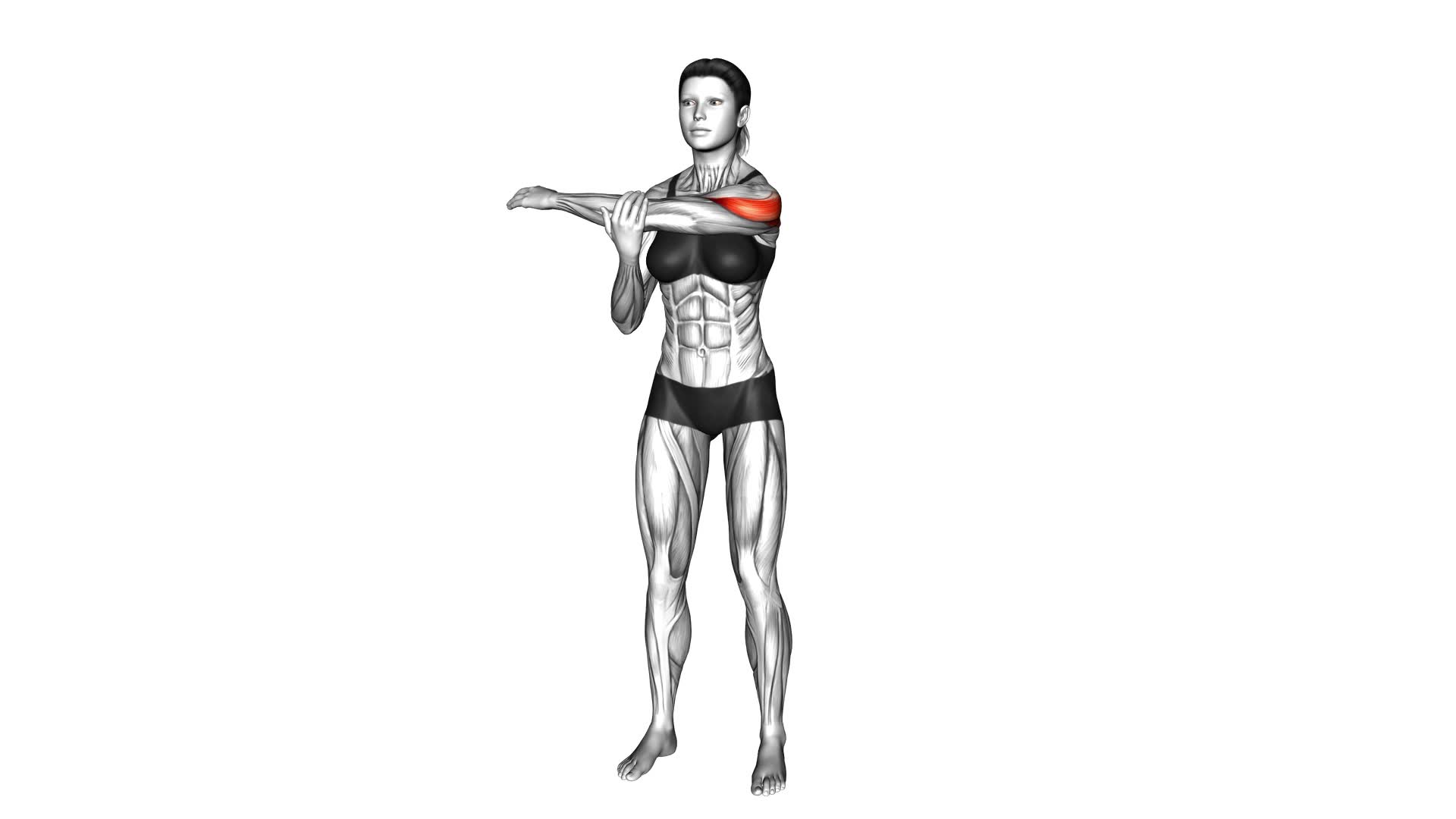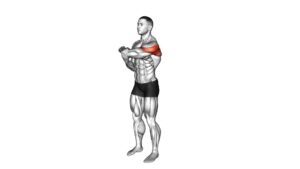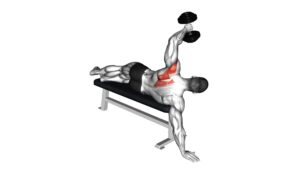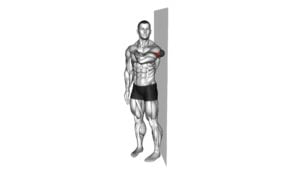Rear Deltoid Stretch (female) – Video Exercise Guide & Tips

Are you looking to target and stretch your rear deltoids? Look no further!
Watch This Exercise Video
This video exercise guide and tips article is here to help you. In just a few minutes, you'll learn the proper technique for the rear deltoid stretch, common mistakes to avoid, and variations for different fitness levels.
Get ready to incorporate this stretch into your workout routine and experience the benefits it has to offer. Let's get started!
Key Takeaways
- The rear deltoid stretch can improve shoulder stability and prevent injuries.
- It can enhance the ability to perform daily activities and alleviate shoulder and upper back pain.
- The stretch targets specific areas of the shoulder complex.
- Proper technique, form, and breathing are important for an effective stretch.
Benefits of the Rear Deltoid Stretch
To maximize the effectiveness of your rear deltoid stretch, it's important to understand the benefits it can provide for your overall shoulder strength and flexibility. The rear deltoid is a small muscle located at the back of your shoulder, and stretching it regularly can lead to significant improvements in your upper body strength and range of motion.
One of the main benefits of the rear deltoid stretch is improved shoulder stability. Strengthening and stretching this muscle can help prevent shoulder injuries and improve your ability to perform daily activities that require shoulder mobility, such as reaching overhead or lifting heavy objects.
Additionally, the rear deltoid stretch can also help alleviate shoulder and upper back pain. By releasing tension in the muscles surrounding the shoulder joint, this stretch can provide relief from tightness and discomfort.
Furthermore, modifying the rear deltoid stretch can target different areas of the shoulder complex. For example, by adjusting the angle of your arm or the height of your hand, you can focus the stretch on specific parts of the rear deltoid or the surrounding muscles.
Equipment Needed for the Stretch
You will need just a few pieces of equipment for the rear deltoid stretch. The best stretches for targeting the rear deltoids include a resistance band and a stable surface, such as a chair or bench.
The resistance band is essential for providing resistance and increasing the effectiveness of the stretch. It allows you to control the intensity and range of motion during the exercise. Choose a band with appropriate resistance level, ensuring that it isn't too easy or too challenging for you.
Additionally, a stable surface, such as a chair or bench, will provide support and stability while performing the stretch. This will help you maintain proper form and avoid any unnecessary strain or injury.
Now that you have the necessary equipment, let's move on to the proper technique for the stretch.
Proper Technique for the Stretch
After obtaining the necessary equipment, continue with the rear deltoid stretch by focusing on the proper technique. To ensure you get the most out of this stretch and avoid common mistakes, follow these tips:
- Stand tall with your feet shoulder-width apart and your knees slightly bent.
- Extend one arm straight out in front of you, parallel to the ground.
- Take your opposite hand and place it on the back of your extended arm, just above the elbow.
- Gently pull your extended arm across your chest, feeling a stretch in the back of your shoulder.
- Hold the stretch for 20-30 seconds, making sure to breathe deeply and relax into the stretch.
- Repeat the stretch on the other side.
Incorporate this stretch into your workout routine by performing it after any upper body exercises that target the deltoids or as part of your cool-down routine. Remember to start with a light stretch and gradually increase the intensity as your muscles warm up. Avoid any jerking or bouncing movements, as these can lead to injury.
Common Mistakes to Avoid
One common mistake to avoid during the rear deltoid stretch is rushing through the exercise without proper form. Many people tend to perform this stretch too quickly, sacrificing the effectiveness of the movement. To ensure that you're getting the most out of your rear deltoid stretch, it's important to maintain a slow and controlled pace throughout the exercise.
Another common mistake is using too much momentum. Instead of relying on momentum to complete the stretch, focus on using the targeted muscles to control the movement.
Additionally, avoid hunching your shoulders or rounding your back during the stretch. This can put unnecessary strain on your neck and spine. Instead, keep your chest lifted and maintain a neutral spine position.
Lastly, be mindful of your breathing. Take deep breaths and exhale as you stretch to enhance the relaxation and effectiveness of the exercise.
Variations and Modifications for Different Fitness Levels
Now let's explore some modifications and variations to accommodate different fitness levels.
If you're just starting out, there are beginner-friendly modifications that can help you ease into the exercise.
On the other hand, if you're more advanced, there are variations that can challenge you further.
Additionally, it's important to tailor exercises to any limitations or injuries you may have to ensure a safe and effective workout.
Beginner-Friendly Modifications
To make the rear deltoid stretch more accessible for beginners, you can start by using a lighter resistance band. This will allow you to gradually build up strength and flexibility in your shoulders without straining yourself. In addition to using a lighter resistance band, here are some other modifications you can make to the rear deltoid stretch to accommodate different fitness levels:
- Beginner modifications:
- Start with a smaller range of motion and gradually increase it as you get more comfortable with the exercise.
- Use a wall or a stable surface for support to help maintain balance and stability.
- Focus on proper form and technique rather than pushing yourself to the limit.
- Advanced modifications:
- Increase the resistance by using a heavier resistance band or adding weights.
- Incorporate other exercises, such as bent-over rows or shoulder presses, to target the rear deltoids from different angles.
- Experiment with different variations of the stretch, such as holding the stretch for longer periods or incorporating pulses for an added challenge.
Advanced Level Variations
To take your rear deltoid stretch to the next level and accommodate different fitness levels, try incorporating advanced variations and modifications.
These advanced level modifications are designed to provide progressions for experienced individuals who are looking to challenge their muscles and improve their flexibility.
One advanced variation is the standing rear deltoid stretch with resistance bands. Attach a resistance band to a stable object and hold the other end with your hand. Step back to create tension in the band and slowly raise your arm out to the side, feeling the stretch in your rear deltoid.
Another modification is the rear deltoid stretch with a foam roller. Lie face down on the foam roller and position it under your shoulder blades. Extend your arms out to the sides and allow your chest to sink towards the ground, feeling the stretch in your rear deltoids.
These advanced modifications provide a deeper stretch and help to target the rear deltoid muscles more effectively.
Tailoring Exercises for Limitations
Adjust your exercises to accommodate different fitness levels and limitations. It's important to recognize that everyone has their own unique circumstances and may require individual modifications. Here are some key considerations when tailoring exercises for limitations:
- Take into account any physical restrictions or injuries that may affect certain movements.
- Adjust the intensity or duration of the exercise to match the individual's fitness level.
- Incorporate modifications or alternative exercises that target the same muscle group but are more suitable for a specific limitation.
By making these adjustments, you can ensure that each person is able to participate in the exercise routine safely and effectively.
Now, let's move on to some tips for incorporating the rear deltoid stretch into your workout routine.
Tips for Incorporating the Rear Deltoid Stretch Into Your Workout Routine
To effectively incorporate the rear deltoid stretch into your workout routine, it's important to focus on proper form and technique. Make sure to maintain a neutral spine, engage your core, and keep your shoulders relaxed.
Additionally, consider the frequency and duration of the stretch. Aim to perform it at least two to three times a week, holding the stretch for 15 to 30 seconds on each side.
Lastly, don't be afraid to explore variations and modifications of the stretch to target different areas of the rear deltoids and prevent muscle imbalances.
Proper Form and Technique
Start by positioning yourself with a slight bend in your knees and your feet shoulder-width apart. This will help to stabilize your body and maintain proper form throughout the exercise.
When performing the rear deltoid stretch, it's important to focus on maintaining proper technique to maximize the benefits of stretching and prevent injury. Here are some tips to help you incorporate the rear deltoid stretch into your workout routine with proper form and technique:
- Keep your spine straight and engage your core muscles to maintain a stable posture.
- Slowly raise your arms out to the sides, keeping them parallel to the ground.
- Maintain a slight bend in your elbows and gently squeeze your shoulder blades together as you stretch.
Frequency and Duration
To effectively incorporate the rear deltoid stretch into your workout routine, continue focusing on maintaining proper form and technique. When it comes to frequency and duration, aim to perform this stretch at least two to three times a week. This will help to improve flexibility and prevent muscle imbalances in your shoulders.
As for timing and intensity, hold the stretch for 15 to 30 seconds on each side and repeat it for two to three sets. It's important to listen to your body and not push yourself too hard, as overstretching can lead to injury.
By incorporating the rear deltoid stretch into your routine with the appropriate frequency, duration, timing, and intensity, you'll enhance your overall shoulder flexibility and strength.
Now, let's explore some variations and modifications to add more variety to your stretching routine.
Variations and Modifications
To incorporate variations and modifications of the rear deltoid stretch into your workout routine, try adding different arm positions or using resistance bands to increase the intensity. Here are some suggestions to help you modify the exercise based on your fitness level:
- Beginner modifications:
- Start with a lighter resistance band or no resistance at all.
- Decrease the range of motion by not pulling your arms back as far.
- Perform the exercise seated or with your back against a wall for added stability.
- Advanced variations:
- Use a heavier resistance band or add dumbbells to increase the resistance.
- Extend your arms out to the sides and hold the stretch for a longer duration.
- Combine the rear deltoid stretch with other shoulder exercises for a more challenging workout.
Frequently Asked Questions
Can the Rear Deltoid Stretch Help Improve Posture?
The rear deltoid stretch can greatly improve your posture.
By targeting the muscles in the back of your shoulders, this stretch helps to improve flexibility and range of motion.
When your rear deltoids are tight, they can pull your shoulders forward, leading to a rounded posture.
By regularly incorporating the rear deltoid stretch into your routine, you can strengthen these muscles and promote better posture.
Is the Rear Deltoid Stretch Suitable for Individuals With Shoulder Injuries?
The rear deltoid stretch is a beneficial exercise for shoulder rehabilitation. However, it may not be suitable for individuals with shoulder injuries. If you have a shoulder injury, it's important to consult with a healthcare professional before attempting this stretch. They can guide you on alternative stretches that are safe and effective for your specific condition.
Prioritizing safety and proper rehabilitation is crucial to prevent further injury and promote healing.
How Often Should the Rear Deltoid Stretch Be Performed for Optimal Results?
To achieve optimal results, it's important to consider how often you should perform the rear deltoid stretch. By regularly incorporating this stretch into your routine, you can effectively target and strengthen the rear deltoid muscles.
However, it's crucial to listen to your body and not overdo it. A good starting point is to perform the rear deltoid stretch two to three times a week. As you progress and feel more comfortable, you can increase the frequency for even better results.
Can the Rear Deltoid Stretch Help Alleviate Upper Back Pain?
Stretching exercises can provide relief for upper back pain. By stretching the muscles, such as the rear deltoids, you can help alleviate tension and improve flexibility in the upper back area.
The rear deltoid stretch specifically targets the muscles in the back of the shoulders, which can often contribute to upper back discomfort. Incorporating this stretch into your routine, along with other stretching exercises, may help provide relief and prevent future pain.
Are There Any Precautions to Consider Before Attempting the Rear Deltoid Stretch?
Before attempting the rear deltoid stretch, there are a few precautions to consider.
- First, make sure you're in good physical condition and have no existing shoulder or neck injuries.
- It's also important to warm up your muscles before performing this stretch to reduce the risk of injury.
However, the benefits of the rear deltoid stretch include improved shoulder mobility, reduced tension in the upper back, and enhanced posture.
Conclusion
Incorporating the rear deltoid stretch into your workout routine can provide numerous benefits, including improved shoulder mobility and reduced risk of injury. This stretch targets the muscles in the back of the shoulders, helping to alleviate tension and improve posture.
By following proper technique and avoiding common mistakes, you can maximize the effectiveness of this stretch. Remember to choose modifications that suit your fitness level and gradually increase the intensity as you progress.
Make the rear deltoid stretch a regular part of your routine for optimal results.

Author
Years ago, the spark of my life’s passion ignited in my mind the moment I stepped into the local gym for the first time. The inaugural bead of perspiration, the initial endeavor, the very first surge of endorphins, and a sense of pride that washed over me post-workout marked the beginning of my deep-seated interest in strength sports, fitness, and sports nutrition. This very curiosity blossomed rapidly into a profound fascination, propelling me to earn a Master’s degree in Physical Education from the Academy of Physical Education in Krakow, followed by a Sports Manager diploma from the Jagiellonian University. My journey of growth led me to gain more specialized qualifications, such as being a certified personal trainer with a focus on sports dietetics, a lifeguard, and an instructor for wellness and corrective gymnastics. Theoretical knowledge paired seamlessly with practical experience, reinforcing my belief that the transformation of individuals under my guidance was also a reflection of my personal growth. This belief holds true even today. Each day, I strive to push the boundaries and explore new realms. These realms gently elevate me to greater heights. The unique combination of passion for my field and the continuous quest for growth fuels my drive to break new ground.







